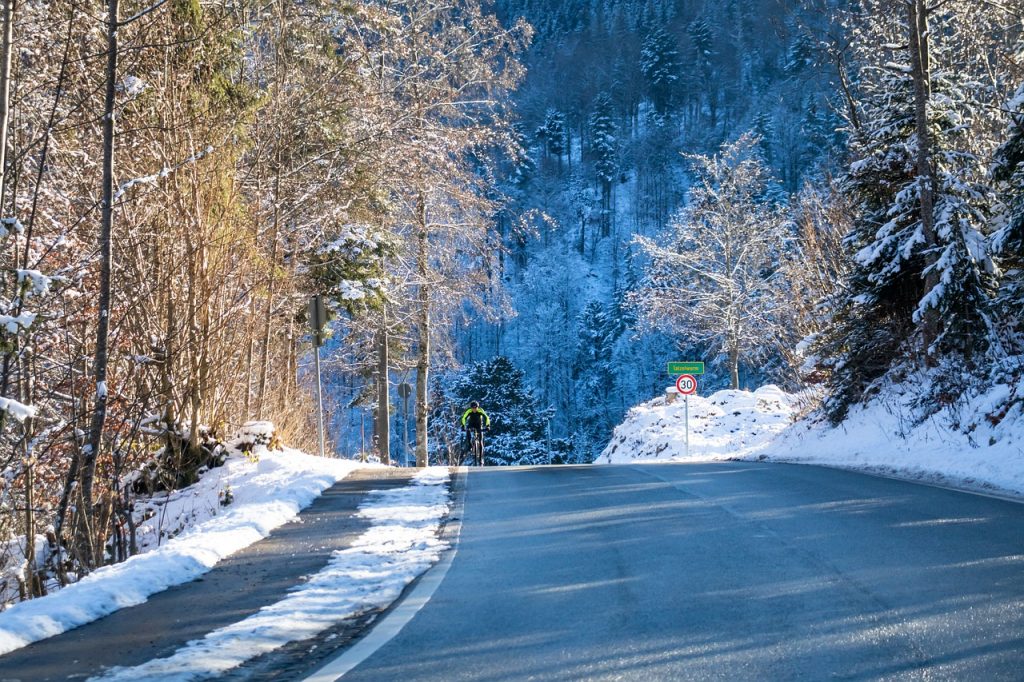Staying Warm In Winter

Textile advances in recent years have meant that it’s easier to keep warm on the bike during periods of cold weather than ever before. Modern ‘Technical’ fabrics and clothing can now keep both warm and dry with the minimum of fuss. And most importantly without having to wear lots of bulky layers of clothing.
In this article we give some best advice for generally keeping warm. We also link to a couple of specific articles that deal with the hands and feet separately as they are always the areas that cause most problems.
Layering
The key to any keeping warm strategy is Layering. It’s been scientifically proven that multiple thin layers of clothing will insulate better than one thick layer. To best achieve this you should start with a thin ‘base layer’. It should be lightweight and able to wick sweat away from your body easily. These are easy to pick up in any sports shop. On top of the base layer, you need an insulating layer such as a winter specific cycling jersey. Lastly you need a wind / water proof layer to keep draughts and the odd shower out. If heavier rain is forecast then you probably want to take a full waterproof jacket.
One word of warning here is that you don’t want too much. You may overheat and have to stop to take something off meaning you’ll get cold again. It will take a little practice to work out what you need but it’s usually best to start off a little chilly and warm up as you ride.
Be Properly Fuelled
Make sure you have eaten before you go out on a ride, a food starved body will retain more blood in the torso causing other parts of the body to become cold. Also make sure you eat and drink regularly while you’re out on your ride to maintain blood sugar levels. There are some pretty good insulated bottles around these days that allow you keep a hot drink going for a couple of hours or so while out – we don’t recommend soup, but a herbal tea will warm and re-hydrate at the same time.
Choose Your Route Carefully
You may not have much choice in your route if you’re doing an organised ride, but if you’re not this is one thing people often overlook. Choosing a fairly flat route will keep you at a constant speed and level of exertion will help to maintain your temperature. You probably want to avoid too many long downhills as not only will you not be working the increased speed and windchill will cool you even further.
Arms
If it’s a little chilly when you start out but you know the weather is going to get better then a decent pair of arm warmers can help to keep the cold at bay. These are the arm sections of a long sleeved cycling jacket that can be worn and removed separately as required. Useful for those days when you need a long sleeve to start with and as the weather improves they can be easily whipped off when you (or the weather) warm up. Leg versions are also available but you will need to stop to remove them unlike arm warmers that can be removed while you ride.
Legs
People often neglect their legs when planning cold weather riding. hey think they will warm up quickly on the bike. Whilst this has a small element of truth, they still need protecting. A good pair of ‘Roubaix’ bib tights will usually provide enough protection. However, don’t be too proud to stick a pair of mountain biking shorts over the top for a bit of extra protection if it helps.
Hands & Feet
Keeping your hands and feet warm can be extremely challenging in the worst of the weather. In general layering works well in both cases as does pre-warming your gloves and socks. For more detailed advice on keeping your hands and feet warm check out our specific articles.
Keeping your hands warm in winter
Keeping your feet warm in winter
Head
It’s a fact that you lose a lot of body heat through your head, but it’s relatively easy compensate for. Assuming you wear a helmet then changing to a non-vented model in the winter will keep more heat in. For extra insulation a thin beanie style fleece hat under your helmet will also help. For your face / neck a buff will help to keep your neck warm. It can also be pulled over your mouth / nose / ears if required. But if it’s really cold you can also use a thin silk balaclava to cover everything in one go.
If you found this advice helpful please consider supporting us by buying a tea at www.buymeacoffee.com/cyclinglabs








